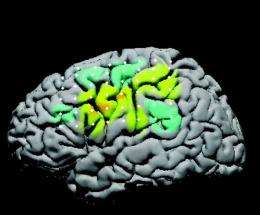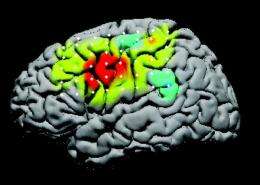Brain-controlled cursor doubles as a neural workout

(PhysOrg.com) -- Harnessing brain signals to control keyboards, robots or prosthetic devices is an active area of medical research. Now a rare peek at a human brain hooked up to a computer shows that the two can adapt to each other quickly, and possibly to the brain's benefit.
Researchers at the University of Washington looked at signals on the brain's surface while using imagined movements to control a cursor. The results, published this week in the Proceedings of the National Academy of Sciences, show that watching a cursor respond to one's thoughts prompts brain signals to become stronger than those generated in day-to-day life.
"Bodybuilders get muscles that are larger than normal by lifting weights," said lead author Kai Miller, a UW doctoral student in physics, neuroscience and medicine. "We get brain activity that's larger than normal by interacting with brain-computer interfaces. By using these interfaces, patients create super-active populations of brain cells."
The finding holds promise for rehabilitating patients after stroke or other neurological damage. It also suggests that a human brain could quickly become adept at manipulating an external device such as a computer interface or a prosthetic limb.
The team of computer scientists, physicists, physiologists and neurosurgeons studied eight patients awaiting epilepsy surgery at two Seattle hospitals. Patients had electrodes attached to the surface of their brains during the week leading up to the surgery and agreed to participate in research that would look at connecting brains to a computer.
Asking people to imagine doing a movement - such as moving their arm - is commonly done to produce a brain signal that can be used to control a device. But how that process works is poorly understood.

"A lot of the studies in this field are in non-human primates," Miller said. "But how do you ask an animal to imagine doing something? We don't even know that they can."
The researchers first recorded brain patterns when human subjects clenched and unclenched a fist, stuck out a tongue, shrugged their shoulders or said the word "move."
Next, the scientists recorded brain patterns when subjects imagined performing the same actions. These patterns were similar to the patterns for actual action but much weaker, as expected from previous studies.
Finally, the researchers looked at signals when subjects imagined performing the action and those brain signals were used to move a cursor toward a target on a computer screen. After less than 10 minutes of practice, brain signals from imagined movement became significantly stronger than when actually performing the physical motion.
"People have been looking at imagined movements as a way to control computers for a long time. This study provides a glimpse of the underlying neural machinery," said co-author Rajesh Rao, a UW associate professor of computer science and engineering who is Miller's neuroscience dissertation advisor.
"The rapid augmentation of activity during this type of learning bears testimony to the remarkable plasticity of the brain as it learns to control a non-biological device," Rao said.
After less than 10 minutes of training, two of the subjects also reported they no longer had to imagine moving the body part and could just think about moving the cursor.
"The ability of subjects to change the signal with feedback was much stronger than we had hoped for," said co-author Dr. Jeffrey Ojemann, a UW professor of neurological surgery. "This is likely to have implications for future prosthetic work."
The new findings also provide clues about which brain signals to tap. Researchers compared the patterns in low-frequency signals, usually used to control external devices, and high-frequency signals, typically dismissed as noise. They discovered that the high-frequency signals are more specific to each type of movement. Because each one occupies a smaller portion of the brain, several high-frequency signals could be tapped simultaneously to control more sophisticated devices.
Rao's group has used electrodes on the surface of the scalp to record low-frequency brain signals for brain-computer communication. His group will now try using such non-invasive methods to harness high-frequency signals.

















